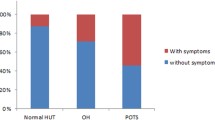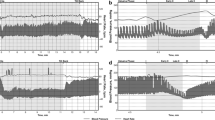Abstract
Dyspnea is a common symptom in patients with pulmonary and cardiac disease. Orthostatic hypotension is rarely considered a cause of dyspnea. We reviewed the medical records of 651 consecutive patients referred for the evaluation of dysautonomia to investigate the prevalence of dyspnea and its association with OH and other autonomic abnormalities. Dyspnea was reported by questionnaire in 30% of patients with OH, compared to 10% of age and sex matched patients without OH (P<0.05, χ2). There was a trend toward earlier blood pressure falls in patients with dyspnea. During autonomic testing, 25% of patients (10 of 40) with OH who reported dyspnea on the questionnaire had shortness of breath coincident with blood pressure falls during tilt table and active standing. The time to maximal blood pressure fall was shorter in patients with OH who experienced shortness of breath during testing compared to those without dyspnea (11 minutes vs. 21 minutes, P<0.05). In this study, dyspnea was frequently associated with OH. Ventilation perfusion mismatch, due to inadequate perfusion of ventilated lung apices may be the most likely underlying cause of orthostatic dyspnea in patients with OH.
Similar content being viewed by others
References
Position paper (1996) Orthostatic hypotension, multiple system atrophy (the Shy Drager syndrome) and pure autonomic failure. J Auton Nerv Syst 58:123–124
American Thoracic Society (1999) Dyspnea. Mechanisms, assessment, and management: a consensus statement. Am J Respir Crit Care Med 159(1):321–340
Caracciolo EA, Chaitman BR, Forman SA, Stone PH, Bourassa MG, Sopko G, et al. (1996) Diabetics with coronary disease have a prevalence of asymptomatic ischemia during exercise treadmill testing and ambulatory ischemia monitoring similar to that of nondiabetic patients. An ACIP database study. ACIP Investigators.Asymptomatic Cardiac Ischemia Pilot Investigators [see comments]. Circulation 93(12):2097–2105
Chiang ST (1968) Anomogram for venous shunt (Qs-Qt) calculation. Thorax 23(5):563–565
Davies SF, McQuaid KR, Iber C, McArthur CD, Path MJ, Beebe DS, et al. (1987) Extreme dyspnea from unilateral pulmonary venous obstruction. Demonstration of a vagal mechanism and relief by right vagotomy. Am Rev Respir Dis 136(1):184–188
Ferry TG, Naum CC (1999) Orthodeoxia-platypnea due to diabetic autonomic neuropathy. Diabet Care 22(5):857–859
Fox JL, Brown E, Harrison JK, Williams J, Terry PB (1989) Platypnea-orthodeoxia and progressive autonomic failure. Am Rev Respirat Dis 140:1802–1804
Hussain SF, Mekan SF (2004) Platypnea-orthodeoxia: report of two cases and review of the literature. South Med J 97(7):657–662
Krowka MJ, Cortese DA (1990) Hepatopulmonary syndrome: an evolving perspective in the era of liver transplantation. Hepatology 11(1):138–142
Lange PA, Stoller JK (1995) The hepatopulmonary syndrome. Ann Intern Med 122(7):521–529
Low PA (1997) Laboratory evaluation of autonomic function. In: Low PA, editor. Clinical autonomic disorders: evaluation and management. Philadelphia: Lippincott-Raven, pp 179–208
Robertson D, Kincaid DW, Haile V, Robertson RM (1994) The head and neck discomfort of autonomic failure: an unrecognized aetiology of headache. Clin Auton Res 4(3):99–103
Seward JB, Hayes DL, Smith HC, Williams DE, Rosenow EC III, Reeder GS, et al. (1984) Platypnea-orthodeoxia: clinical profile, diagnostic workup, management, and report of seven cases. Mayo Clin Proc 59(4):221–231
Valensi P, Sachs RN, Harfouche B, Lormeau B, Paries J, Cosson E, et al. (2001) Predictive value of cardiac autonomic neuropathy in diabetic patients with or without silent myocardial ischemia. Diabetes Care 24(2):339–343
Wranne B, Tolagen K (1978) Platypnoea after pneumonectomy caused by a combination of intracardiac right-toleft shunt and hypovolaemia. Relief of symptoms on restitution of blood volume. Scand J Thorac Cardiovasc Surg 12(2):129–131
Author information
Authors and Affiliations
Corresponding author
Rights and permissions
About this article
Cite this article
Gibbons, C.H., Freeman, R. Orthostatic dyspnea: a neglected symptom of orthostatic hypotension. Clin Auton Res 15, 40–44 (2005). https://doi.org/10.1007/s10286-005-0227-1
Received:
Accepted:
Issue Date:
DOI: https://doi.org/10.1007/s10286-005-0227-1




